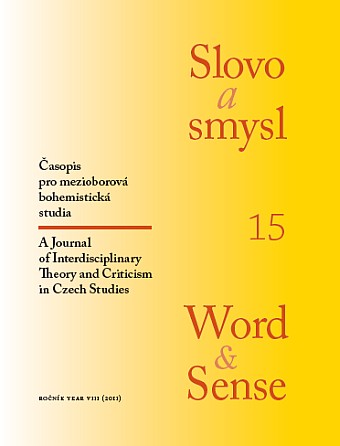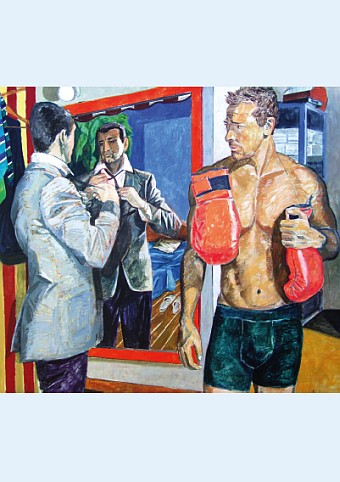Editorial
This issue is connected with a very specific place, time, and mood. Kodaňská Street in old Vršovice still retains the magic of a turn‑of‑the‑century avenue, though neglected by the Town Hall, with the pompous architectural ostentation of early twentieth‑century Czech buildings. It comes to life magnificently in the summer, when the many beer gardens that line the street reach full bloom. The smallest and coziest garden is the one in front of Nanocafe. On summer evenings, as the dazzling sun sets over Kodaňská Street, creating remarkable optical illusions, we who live nearby may experience illusory “holidays”, even when, although officially on “vacation”, we have spent the entire day feverishly finishing up the reading and writing that we had no time for during the academic year. Summer is in essence always a contest with time; we enter it as though embarking on an anticipated but still empty book that cannot be written any other time. These days an academic’s summer consists in the race of an exhausted runner and the concert of a creaky typewriter. But in a garden on Kodaňská Street, if only for a while, one may sense intellectual life as it was in those mystical times, when it was still possible to lounge in cafes, pondering, debating, or simply relaxing and observing life… On one such evening, our conversation turned to recently published texts on gender. We lamented that academics write about gender as though it were a duty, as though writers were never happy to be writing on the subject, and that their writings seem mechanical, without originality or wit. To put it simply – they write with very little joy. And thus the idea for this issue arose, an issue on joyful gender, a selection of texts that show ease, esprit, and delight – in short, the joy embodied in the appellation, “the gay science”…
This issue is thus not only the consequence of the illusion of free summer days, but also the illusion of the liberated spirit, which has inspired us not only to play joyfully with the possibilities of gender studies and theories, but has also permitted us to discover, in Friedrich Nietzsche’s words, “much that is irrational and preposterous, a great deal of playful tenderness, lavished even on thorny problems that do not lend themselves to caresses and enticement.” Thus we did not want to limit the conception of this issue to specific approaches to gender analysis or to one field of inquiry. Joyfully shining through the prism whose core is the category of gender, the light of our enthusiasm has illuminated various arts (literature, the fine arts, and (proto‑) film). It has penetrated into the recesses of various scholarly disciplines and intellectual trends (philosophy, history, sociology, film studies, archaeology, and occultism), and flooded both the private and the public sphere, both high and popular art forms. The responses of our contributors – infected by our “joy”? – fill the entire issue, and their reflections on the gender question are not limited to thematic studies and essays, but have inspired a lively dialogue on their common theme. In addition, the debate on methodology extends from scholarly studies to critical responses.
One approach to gender is to consider it a socially predefined concept. This enables the scholar to reveal the possibility of a specifically feminine voice, for instance, on the boundary between the opera stage and romance stories (Barbara Straumann: A Voice of Her Own? Feminine Voice Effects in George Du Maurier, George Bernard Shaw and Isak Dinesen). In addition, a specifically feminine manuscript may be born from the tension between private inner integrity and a public role (Libuše Heczková – Kateřina Svatoňová: Three Women, Three Diaries). Women’s writing may be associated with a specific space (Elena Sokol: A City of One‘s Own: The Intersection of Urban Space and Consciousness in Novels by Daniela Hodrová and Virginia Woolf), or it may defend a worldview that is in conflict with stereotypically defined roles (Zuzana Ticháčková: Religiosity in the Work of Anna Pammrová; Anna Pammrová: Illegible Diaries) and resists established norms (Kateřina Kunová: Damn! That Is Material, That Is Material! Don’t You Want to Write It Up for Us?: The Carnival of Sexuality in the Work of Svatava Antošová). In the realm of theory we may observe the (internal) struggle not only for one’s own position, for feminine writing, but also for new concepts, as investigated by Laura Mulvey (Petra Hanáková – Libuše Heczková: Conversation with Laura Mulvey), a film theorist who has fundamentally changed thinking about the cinematic experience by merging feminist and psychoanalytic theories. Theoretical concepts of reading gender may also serve as a stimulus for the revision of research methods and their conclusions in disciplines that have thus far been overlooked in gender studies (Kamila Remišová Věšínová: Gender in Archaeological Interpretation).
Another approach is to read texts that transform gender conceptions and turn them into lenses that may be placed between the reader‑spectator and the work; thus individual characteristics, objects, and characters hitherto unnoticed and invisible begin to emerge. Completely different structures are revealed, and unusual situations are played out, which would hardly be discovered through textual or visual analysis using other methodological tools (Jan Hušek: Dumplings Are Difficult to Warm Up…: Notes on the Place of Women and Girls in the Work of Jaroslav Foglar; Zdeňka Kalnická: Meeting with Salvador Dali on the Way to Andro-gyne. Metamorphosis of Narcissus. Movement between visible and invisible gender filters inevitably leads us to another possibility: the merging of opposites, the search for “neutral,” “in between” positions, which appear only after the two established positions of a fixed duality are placed in doubt. This is why precisely an apparently “non‑gendered” text reveals entirely new possibilities for individual thought, creation, and being in socially given structures based on the differentiation of genders (Tomáš Jirsa: The Physiognomy of Writing: French Literary Thought and its Visual Inspiration).
The section Critical Views opens with a review of the book History of New Modernism (by Hana Šmahelová), followed by critical evaluations of an extensive collection of essays by the well‑known “troublemaker” Robert Pynsent (Luboš Merhaut) and historical research on (Czech) everyday life (Jan Randák); that is, reflections on books that are concerned not only with historical definitions of the category of gender, but also with the phenomenon of femininity, from debates about the otherness of woman to polemics with external expressions of feminism and analysis of creative works by women.
Individual explorations into the realms of women’s thought and thought about women, gender analyses and analyses of gender, thus form the mosaic that problematizes or subverts the social limits of gender as they are represented in art. We hope that the joy that inspired this issue, as well as the specific atmosphere of a certain place, a summer avenue beneath the sunset, are not lost in this mosaic… Therefore, for English‑speaking readers we conclude with the introduction to a light yet deeply tragic social story, The Angel Maker by the anarchist Michal Mareš, on an occupation that was open only to women (with a foreword by the translator David Short).
It remains only to add: may we be “superficial from the depths,” as Friedrich Nietzsche proclaimed in The Gay Science.
Petra Hanáková, Libuše Heczková, Eva Kalivodová, Kateřina Svatoňová


